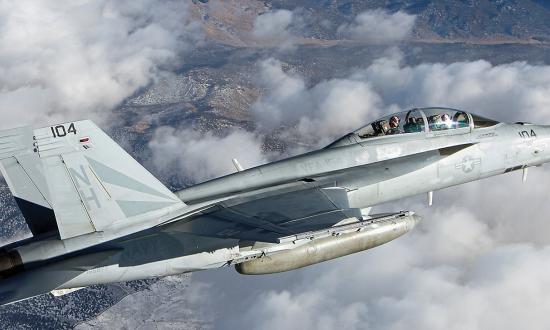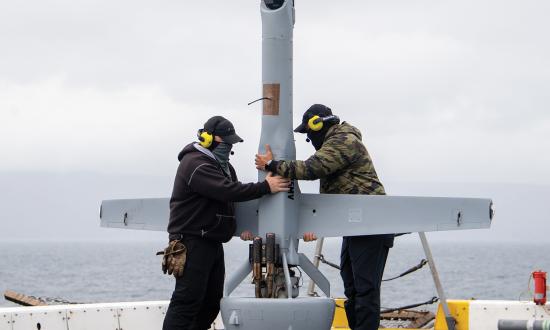In multiple venues and documents, Chief of Naval Operations Admiral Michael Gilday has made clear his intent regarding unmanned systems in the future fleet. For example, in his January 2021 Navigation Plan, he writes, “Unmanned platforms play a vital role in our future fleet. Successfully integrating unmanned platforms—under, on, and above the sea—gives our commanders better options to fight and win in contested spaces.”1 This should refocus naval aviation’s efforts to man, train, and equip its growing fleet of unmanned aerial systems (UASs).
Unfortunately, MQ-8B Fire Scouts deployed onboard littoral combat ships (LCSs)—naval aviation’s largest UAS footprint—are being underused in the current composite manned/unmanned unit manning structure. Composite manned/unmanned units look good on paper but introduce operational issues and must be decoupled. Naval aviation needs a dedicated cadre of unmanned aviators.
The current Fire Scout deployment structure includes one MQ-8, one MH-60S Knighthawk helicopter, and 25 personnel. This composite aviation detachment (AvDet) is sourced from a stateside squadron, which supports the deployed units and includes a mix of manned and unmanned aircraft to train future detachments. The MH-60S is an established platform, proven both ashore and on every aviation-capable ship in the fleet since its initial deployment in 2003.2 The MQ-8 does not have quite the same track record, but it does boast more than 17,000 flight hours, successful operational missions, and years of deployments.3 Four composite fleet helicopter sea combat (HSC) squadrons employ the MQ-8B/C along with the MH-60S. While the Knighthawk supports a wide array of missions, spanning from personnel recovery to airborne mine countermeasures, the Fire Scout excels as an airborne sensor.
Currently, naval aviation is upgrading from the MQ-8B to the MQ-8C Fire Scout variant. The MQ-8C is a completely new airframe and can remain airborne more than twice as long as the MQ-8B while carrying more than three times the payload.4 Both aircraft employ the Brite Star II multisensor imaging system, but the MQ-8C will carry the improved surface search AN/ZPY-8 radar system. The MQ-8C also has available payload capacity for future incorporation of passive sensors, networking capability, and, potentially, antisubmarine warfare (ASW) equipment.
Based on the widely used Bell 407 airframe, the MQ-8C even boasts a massive supply network and history of aircraft reliability.5 When the MQ-8C successfully completes its developmental and operational flight test, LCS crews will be able to operate the Fire Scout for nearly a third of a day without having to keep the crew at flight quarters to recover the aircraft to refuel.6
Composite Manning Problems
The current AvDet consists of 4 to 5 officers, 1 chief petty officer, 4 enlisted aircrewmen, and 15 to 16 enlisted maintainers. By comparison, a standard two MH-60S detachment on board other ships would deploy with 35 personnel, but LCS AvDet sizes are strictly limited because of the tight berthing constraints. Therefore, most LCS AvDet personnel must qualify to operate or maintain both the MH-60S and the MQ-8—two completely different aircraft. Recent, temporary changes in the wake of multiple Class A MQ-8 mishaps mandate that selected officers fly the MQ-8 exclusively during deployment and revert to MH-60 operations after deployment. Currently, one or two naval aviators in each detachment operate the MQ-8 and the remaining pilots fly the MH-60S. This reduces MH-60S operator availability and continues to limit the growth of UAS expertise. Accordingly, the four HSC squadrons that provide these units develop similar pools of officers and enlisted members to operate and maintain the different aircraft.
Many of the mission functions are identical on both platforms, so one might assume that training and experience in the MH-60S directly translate to the MQ-8B/C. For example, a detachment could execute the search phase of an airborne search-and-rescue mission with either the MQ-8B/C or the MH-60S. The composite unit also can fly both platforms simultaneously under ideal conditions, sharing the single landing spot on the embarked LCS. Unfortunately, while experience shows the composite structure can work in a limited fashion, it has several drawbacks that call for a significant change to the unmanned deployment model and associated administrative command structure.
The primary negative impact of the composite deployment structure is the consistent shortchanging of unmanned aviation priorities. When manned and unmanned requirements conflict (as they often do), manned aviation almost always wins. This makes sense—unmanned flight operations do not place the operators’ lives at risk.
However, in the wider naval aviation community, this manned-over-unmanned mentality was evident during the fiscal year 2022 Aviation Command Screen Board. The board selected 12 officers to command operational HSC squadrons, including the four composite MH-60S/MQ-8B/C units. Of these future commanding officers, major commanders, and potential flag officers, none had UAS experience. The manned-over-unmanned message was clearly heard by the current cadre of ambitious midgrade naval aviators.7 Career incentives for pilots and aircrewmen remain skewed in favor of manned platforms.
A second negative effect of the mixed deployment structure is that it wastes time and money in requiring unmanned operators to complete the same training as pilots and aircrew for manned vehicles. It takes approximately 2.5 years for an MH-60S pilot and one year for an enlisted aircrewman (including Rescue Swimmer School) to reach the fleet.8 It takes only six months for an Air Force remotely piloted aircraft (RPA) pilot to complete initial training.9 A UAS-only flight training syllabus would cost a fraction of the traditional naval aviator training pipeline, mainly because nearly all the instruction could be completed in simulators. Furthermore, the physiological attrition manned aviators succumb to would not apply to unmanned operators. UAS experts are not restricted by airsickness or the need for corrected 20/20 vision.
Finally, deploying two dissimilar aviation platforms ignores an age-old naval aviation truth—aircraft break unexpectedly. Composite AvDets leave for deployment with one aircraft of each type. The “two makes one, and one makes none” aviation aphorism suggests this is not optimal. In addition, as LCSs were built to operate cheaply and independent of the carrier strike group, they often deploy to areas without established logistical support hubs. Replacement parts can take weeks to reach the ship, with the respective aircraft in a down status during the entire waiting period.
An Unmanned Organization
The Navy should stop using the composite AvDet deployment model. Rotary-wing detachments should deploy as exclusively manned or unmanned teams. With more LCS reliability and the addition of the Constellation-class frigates to the fleet later this decade, these homogenous units could operate in support of each other. One ship could focus on manned aviation, while a neighboring ship on unmanned aviation. Eliminating composite aviation detachments also would negate the need for composite supporting squadrons and wings.
It also would allow Fire Scout squadrons to merge with units supporting the MQ-4 Triton and MQ-25 Stingray—a potential new unmanned aviation wing and nascent unmanned aviation community.10 Despite external appearances, these three aircraft have more in common with each other than with manned type wing aircraft.
Finally, the Navy should develop specific training and career tracks for unmanned aviation. The MQ-25 program already has initiated an effort in this vein, and both the MQ-8B/C and MQ-4 programs could follow. With the operators for all three aircraft following unmanned career paths, they could merge into a single talent pool. A pilot could do consecutive tours with Fire Scout, Triton, and Stingray squadrons, with minimal additional training required. The initial officer talent pool for air-vehicle operators could be a mix of direct-accession naval unmanned aviators, as currently planned with the MQ-25, lateral-transfer officers from manned aviation, and physiological attrites from flight school.11 Enlisted mission-payload operators could form a healthy pool for a new unmanned aircrewmen rating and similarly move among the platforms from tour to tour.
Naval aviation also should implement a 1330 officer designator to recognize the unique skills associated with unmanned aviation and place all operational unmanned aerial systems under an unmanned aviation wing. These officers would complete aviation preflight indoctrination with their manned aviation peers, have their own flight-school syllabus, and enter the fleet after receiving unmanned airframe-specific training. Unlike the MQ-25 warrant officer program, these 1330 unmanned aviators would be eligible to command unmanned aviation units. This is essential for successful Navy unmanned programs, as leaders must be grown from within.
Coupling a UAS requirement to an already stretched MH-60 aviation detachment, squadron, or wing creates unrealistic capability expectations while constraining UAS professional development. The Navy must evolve past the limitations of the composite manned/unmanned construct. Reforming the Navy’s manpower structure to better support unmanned systems will allow naval aviation to meet the challenge.
1. U.S. Navy, Chief of Naval Operations Navigation Plan, January 2021, 11.
2. “MH-60S Knighthawk (Seahawk) Multimission Naval Helicopter,” Naval Technology, 14 August 2020.
3. Department of Defense, “MQ-8 Fire Scout Unmanned Aircraft System (MQ-8 Fire Scout), as of FY2021 President’s Budget,” Defense Acquisition Management Information Retrieval, December 2019.
4. Naval Air Systems Command, “MQ-8C Fire Scout,” www.navair.navy.mil/product/mq-8c.
5. Mark Hubner, “Bell 407,” Business Jet Traveler Online, February 2012.
6. Naval Air Systems Command, “MQ-8C Fire Scout.”
7. Naval Personnel Command, “Order Convening the FY-22 Active Aviation Commander Command Screen Board,” 3 March 2021.
8. “Aviation Rescue Swimmer Careers,” Navy.com.
9. Joint Base San Antonio–Randolph Public Affairs, “Air Force RPA Training Pipeline Set to Expand,” 20 August 2015.
10. LT Daniel Whitsett, USN, “The Argument Against Composite Manned-Unmanned Teaming,” Association of Naval Aviation’s Wings of Gold Magazine, Fall 2020; Whitsett, “Making Manned-Unmanned Teaming Work for the Future of Naval Aviation,” Association of Naval Aviation’s Wings of Gold Magazine, Winter 2020.
11. U.S. Navy, NAVADMIN 315/20: “Establishment of the Aerial Vehicle Operator (AVO) Warrant Officer (WO) Community,” 9 December 2021.







